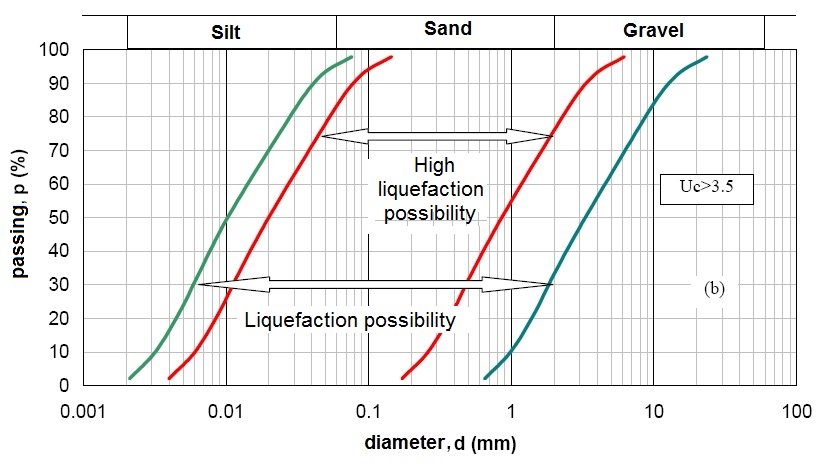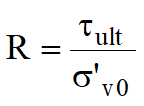The phenomenon of liquefaction affects the saturated sand deposits which, in the course of a seismic event, or more generally during and immediately after a stress of cyclic type, undergo a drastic reduction of shearing resistance.
It is also now generally accepted that the main cause of liquefaction of saturated sandy soils, which occurs in the course of seismic events, is attributable to the increase in pore water pressures induced by cyclic shear stresses, which are due to the propagation of shear waves in the soil. The application of a succession of cyclic efforts in drained conditions initially generates a reduction of volume, however, if the stress occurs very rapidly compared to the drainage capacity of the deposit, it follows that the reduction of volume can not occur and the volume element will be subjected to an undrained loading process. The prevented volumetric strain will be accompanied by an increase in pore water pressure and a reduction of effective stresses, having to remain constant the total stresses. The increment of pore water pressure depends on the degree of densification of the soil and on the extent of the cyclic stress. If the ground is in a little dense state and the cyclic stress is sufficiently high, the increase in pore water pressure that follows can match the effective confinement stress and the soil particles are no longer subjected to any inter-granular stress.Under such conditions, and with no cohesion, the soil no longer has any resistance to shearing.

Sandy saturated soil before the effect of liquefaction (left figure), are seen the stresses that are exchanged (grains
represented by the red arrows). Saturated sandy soil in liquefaction (the inter-granular stresses are absent)
CASES WHERE LIQUEFACTION IS EXCLUDED (EC8)
The liquefaction check can be omitted when it occurs at least one of the following circumstances:
1.Expected seismic events with a magnitude M less than 5
2.Maximum expected acceleration at the surface less than 0.1 g
3.Maximum expected acceleration at the surface less than 0.15g and soils with characteristics that fall into one of three categories:
•FC>20%, IP>10
•FC≥ 35%, N’SPT (corrected-normalized) >20
•FC≤5%, N’SPT (corrected-normalized) >25 ;
where:
pa is the atmospheric pressure σ’v the effective vertical pressure
|
4.Material with Uc < 3.5 – Grain size of the soil outside the areas indicated in the image A
5.Material with Uc > 3.5 – Grain size of the soil outside the areas indicated in the image B
6.Seasonal average depth of the groundwater table greater than 15 m (as long as the ground surface is sub-horizontal and structures with shallow foundations).

A – Critical grain size bands Uc< 3.5

B – Critical grain size bands Uc>3.5
Seed and Idriss
The method used by LoadCap to estimate the liquefaction of a sandy saturated soil during a seismic event is that proposed by Seed and Idriss, the best known and most used of the simplified methods.
The method is based on the number of blows of the test Standard Penetration Test and only requires the knowledge of a few geotechnical parameters: the grain size, the relative density, the unit weight.
With this method, the liquefaction resistance factor FS is calculated by the ratio between the capacity of normalized resistance (R) and the application of cyclic resistance (T), multiplied by a scaling factor calculated considering an expected seismic event of a magnitude M = 6.5 which assumes a constant value equal to 1.19 (worst condition).
The capacity of normalized resistance with respect to the initial effective vertical pressure is expressed by the following relationship:

and can be determined from the graphic shown in the image below, as a function of the parameters derived from SPT suitably corrected and normalized.

Correlation between cyclic resistance capacity and corrected numbers of blows of a dynamic penetration test (N'SPT)
The application of cyclic resistance is expressed by the relationship:

where:
g acceleration of gravity;
![]() v
v ![]() 'v respectively the total vertical pressure and the effective pressure at the considered depth;
'v respectively the total vertical pressure and the effective pressure at the considered depth;
| rd= 1-0.015z | corrective coefficient that takes into account the deformability of the ground at the passing of the seismic shearing waves. |
In the expression of the resistance application (T), to take account of the sporadic nature of the acceleration peaks, it is corrected the maximum cyclic stress induced by the earthquake by 35% obtaining a value of "equivalent uniform stress". If SF > 1.3 the soil is considered non-liquefiable.
© GeoStru
